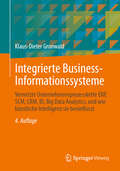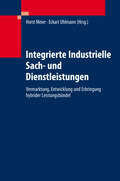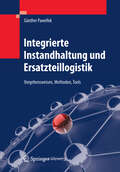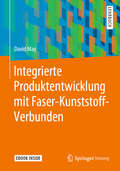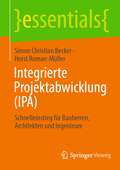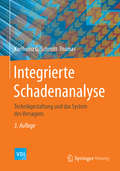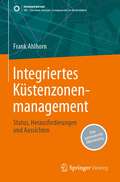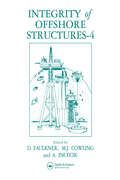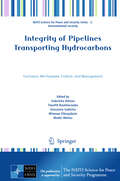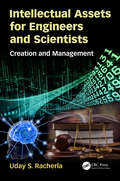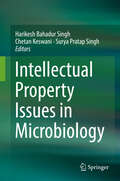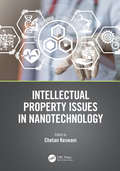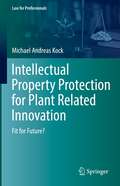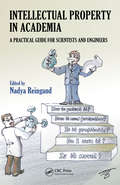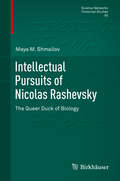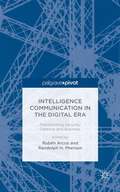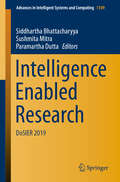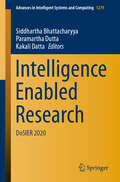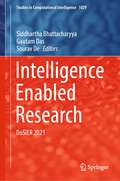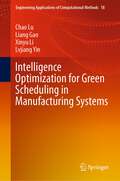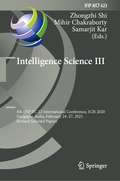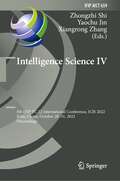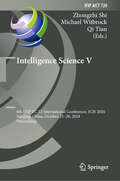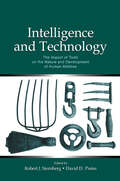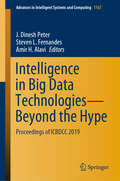- Table View
- List View
Integrierte Business-Informationssysteme: Vernetzte Unternehmensprozesskette ERP, SCM, CRM, BI, Big Data Analytics, und wie künstliche Intelligenz sie beeinflusst
by Klaus-Dieter GronwaldEnterprise Resource Planning (ERP), Supply Chain Management (SCM), Customer Relationship (CRM), Business Intelligence (BI), und Big Data Analytics sind unternehmerische Aufgaben und Prozesse, die durch standardisierte Softwarelösungen realisiert werden. Methoden der künstlichen Intelligenz wie Machine Learning, generative KI und Computer Vision beeinflussen und steuern diese Prozesse. Dieses Lehrbuch lässt Studierende aus der Businessperspektive erfahren, wie diese Methoden vernetzt sind, wie sie sich gegenseitig beeinflussen und wo ihre Grenzen sind. Dadurch wird managementorientiertes Denken und Handeln vermittelt, das für Informatiker, die sich mit geschäftsprozessorientierten IT-Lösungen befassen, unerlässlich ist.
Integrierte Industrielle Sach- und Dienstleistungen
by Eckart Uhlmann Horst MeierHybride Leistungsbündel (HLB) dienen dazu, ein innovatives und nutzenorientiertes Produktverständnis von Sach- und Dienstleistungen zu etablieren. Hochkomplexe Anlagen lassen sich durch diese integrierte Betrachtung von Sach- und Dienstleistungsanteilen deutlich besser vermarkten. Der Band liefert einen Überblick zu diesem Konzept und stellt entsprechende Methoden und Werkzeuge zur Entwicklung von Sach- und Dienstleistungen vor. Dabei berücksichtigen die Autoren den gesamten Zyklus: von der Planung und Entwicklung bis zur Erbringung und Nutzung.
Integrierte Instandhaltung und Ersatzteillogistik
by Günther PawellekIn dem Leitfaden wird die Analyse- und Entscheidungssystematik zur Gestaltung integrierter Instandhaltung und Ersatzteillogistik beschrieben. Gezeigt wird, wie die Prozesse mit einem integrierten Planungsansatz und neuen Analyse- und Bewertungstools auch langfristig verbessert werden können: durch zielgerichtetes und strukturiertes Vorgehen, die Einbeziehung anlagen- und komponentenspezifischer Aspekte und durch permanentes Monitoring. Das Buch richtet sich an Ingenieure sowie Führungskräfte und Mitarbeiter in Instandhaltung und Ersatzteillogistik.
Integrierte Produktentwicklung mit Faser-Kunststoff-Verbunden
by David MayFaser-Kunststoff-Verbunde (FKV) bieten herausragende Vorteile, von denen das hohe Leichtbaupotenzial der wohl markanteste, aber bei weitem nicht der einzige ist. Für eine effiziente und erfolgreiche Produktentwicklung mit FKV, die diese Vorteile ausschöpft, ist dabei eine integrierte Produktentwicklung erforderlich. Dieses Buch vermittelt die hierfür notwendigen Grundlagen. Einleitend werden die materialspezifischen Vorteile von FKV und daraus abgeleitet die typischen Anwendungsgebiete vorgestellt. Anschließend wird aufgezeigt, welche Probleme eine konventionelle, nicht integrierende Produktentwicklung erzeugt, und wie diese durch ein integrierte Produktentwicklung (IPE) überwunden werden. Zudem wird erläutert wieso IPE gerade für FKV von Bedeutung ist. Im Hauptteil des Buches wird zunächst ein Ansatz zur IPE von FKV-Bauteilen vorgestellt. Der weitere Aufbau des Buches entspricht dieser Vorgehensweise und erklärt Schritt für Schritt, wie zunächst ein Anforderungskatalog erstellt und darauf basierend, ein Konzept, ein Entwurf und schließlich eine ausgearbeitete Konstruktion entstehen. Dabei werden auch einfache, aber effektive Methoden für die Auswahl von Fasermaterialien, Halbzeugen und Fertigungsverfahren definiert. Deren Anwendung erlaubt es, bereits in einem frühen Stadium des Entwicklungsprozesses grundlegende Entscheidungen zu treffen, die als Basis für die Entwicklungen in den verschiedenen Bereichen dienen. So wird eine effiziente, simultane Entwicklung konstruktiver, fertigungstechnischer und werkstofflicher Aspekte ermöglicht. Ein abschließendes Kapitel beschreibt einen Ansatz zur technoökonomischen Bewertung, mit dem eine finale Entscheidung zwischen verschiedenen Alternativen getroffen werden kann. Anhand praxisnaher Anwendungsbeispiele wird den Lesern aufgezeigt, wie das erlangte Wissen in der Praxis umgesetzt werden kann.
Integrierte Projektabwicklung: Schnelleinstieg für Bauherren, Architekten und Ingenieure (essentials)
by Simon Christian Becker Horst Roman-MüllerDie Integrierte Projektabwicklung (IPA) ist ein neues Verfahren, um insbesondere große komplexe Bauprojekte erfolgreich umzusetzen. In Deutschland noch wenig bekannt, beginnt es sich auch hier zu etablieren. Dieser Schnelleinstieg stellt die IPA und ihren innovativen Denkansatz vor. Dazu gehören eine frühzeitige Einbindung aller wesentlichen Beteiligten, das Prinzip der Einstimmigkeit sowie eine von Respekt und Vertrauen geprägte Projektkultur. Ein neues Vergütungsmodell liefert zusätzlich Anreize zur Kooperation mit dem Ziel, gemeinsam das Beste für das Bauprojekt zu erreichen.
Integrierte Schadenanalyse: Technikgestaltung und das System des Versagens (VDI-Buch)
by Karlheinz G. Schmitt-ThomasDieses Buch behandelt die systematische und nachvollziehbare Klärung der Ursachen und der Ereignisabfolgen bei technischen Versagensabläufen, Schäden und Schwachstellen, ausgehend von werkstoffkundlichen Untersuchungen. Es bietet für den Gutachter wie für den planenden Ingenieur Grundlagen, um große wirtschaftliche Schäden und Katastrophen vermeiden zu können.Die Schadenanalyse wird nach einer speziellen Systematik unter Beachtung von Ereignisketten an Beispielen und in Fallstudien dargestellt. Möglichkeiten und Grenzen verschiedener Untersuchungsverfahren werden aufgezeigt. Das Buch bietet zudem eine schlüssige Darstellung der systematischen Schaden- und Schwachstellenanalyse. Vorgehensweisen, Untersuchungsmethoden und Schadenbeispiele werden in eine strenge Systematik eingeordnet.
Integriertes Küstenzonenmanagement: Status, Herausforderungen und Aussichten (SDG - Forschung, Konzepte, Lösungsansätze zur Nachhaltigkeit)
by Frank AhlhornDieses Buch gibt einen kurzen, aber umfassenden Überblick über das Integrierte Küstenzonenmanagement. Am Beispiel der Wasserwirtschaft ermöglicht es dem Leser, die unterschiedlichen Interessen und Anforderungen zu verstehen. Es ist als Lehrbuch für Studenten gedacht, kann aber auch von Fachleuten in der Verwaltung sowie im Projektmanagement und in der Planung verwendet werden. Durch die Zusammenfassung hydrologischer Aspekte verdeutlicht es die Herausforderungen im Wassermanagement (z. B. Küstenschutz, Entwässerung und Flussmanagement). Außerdem werden die Grundsätze und Methoden für Integration und gute, kooperative Prozesse unter Berücksichtigung der Interessen und Anforderungen in den Küstengebieten vorgestellt. Das Buch konzentriert sich auf den Status quo in Europa, mit Beispielen aus den Niederlanden, Deutschland und Spanien, und bietet aktuelle Einblicke in die Vereinigten Staaten von Amerika oder Australien. Der Autor erweitert den Blick durch kurze Behandlung zusätzlicher Themen, wie die Einbeziehung historischer Betrachtungen.
Integrity of Offshore Structures
by D. FaulknerPapers presented at the Fourth International Symposium on Integrity of Offshore Structures, 2-3 July 1990, Kelvin Conference Centre, University of Glasgow, Scotland organized by the Department of Naval Architecture and Ocean Engineering and Mechanical Engineering.
Integrity of Pipelines Transporting Hydrocarbons
by Giovanna Gabetta Mekki Mellas Taoufik Boukharouba Gabriella Bolzon Mimoun ElboujdainiThis book describes technical and practical aspects of pipeline damage. It summarizes the phenomena, mechanisms and management of pipeline corrosion in-service. The topics discussed include pipelines fracture mechanics, damage mechanisms and evolution, and pipeline integrity assessment. The concept of acceptable risk is also elucidated and the future application of new knowledge management tools is considered.
Intellectual Assets for Engineers and Scientists: Creation and Management
by Uday S. RacherlaEngineers and scientists engaged in creative works, inventions, and innovations – as part of the free-enterprise, free-market system – must understand what Intellectual Property Rights (IPRs) are and know how to strategically use them to create competitive advantage, wealth, and value. An acknowledged, major contributing factor to non-awareness amongst technical audience is the lack of availability of easily-understandable, business-relevant, and comprehensive books on the subject, that scientists and engineers can access. This book will provide comprehensive, easy-to-understand, innovation management perspectives on a wide range of IPRs for practicing scientists and engineers. Key Features: • One-stop shop for valuable information on all forms of IPRs for technical audience • Strong innovation management component along the lines of technology for business and innovations for customers, and IP laws for protecting and unlocking the value of creative works, inventions, and innovations • Gives easy-to-read, easy-to-follow innovation management perspectives • Emphasizes IPR-related topics of practical relevance • Compares the IP Systems of United States and others (EU, China & India)
Intellectual Property Issues in Microbiology
by Harikesh Bahadur Singh Chetan Keswani Surya Pratap SinghIn the current era current era of significant innovations, science and technology are powerful tools improving human welfare through prosperity and sustainable development. The development of microbiology based industries in any given country is shaped by the characteristics of its technology—particularly its close relation to scientific knowledge, and by country-specific factors such as the level and nature of the scientific knowledge base, the institutional set-up, and the role assumed by the government, all of which influence the country's ability to exploit the new opportunities.This unique book presents an integrated approach for sustained innovation in various areas of microbiology. Focusing on the industrial and socio-legal implications of IPR in microbiological advances, it offers a comprehensive overview not only of the implications of IPR in omics-based research but also of the ethical and intellectual standards and how these can be developed for sustained innovation.The book is divided into three sections discussing current advances in microbiological innovations, recent intellectual property issues in agricultural, and pharmaceutical microbiology respectively. Integrating science and business, it offers a glimpse behind the scenes of the microbiology industry, and provides a detailed analysis of the foundations of the present day industry for students and professionals alike.
Intellectual Property Issues in Nanotechnology
by Chetan KeswaniIntellectual Property Issues in Nanotechnology focuses on the integrated approach for sustained innovation in various areas of nanotechnology. The theme of this book draws to a great extent on the industrial and socio-legal implications of intellectual property rights for nanotechnology-based advances. The book takes a comprehensive look not only at the role of intellectual property rights in omics-based research but also at the ethical and intellectual standards and how these can be developed for sustained innovation. This book attempts to collate and organize information on current attitudes and policies in several emerging areas of nanotechnology. Adopting a unique approach, this book integrates science and business for an inside view of the industry. Peering behind the scenes, it provides a thorough analysis of the foundations of the present day industry for students and professionals alike.
Intellectual Property Protection for Plant Related Innovation: Fit for Future? (Law for Professionals)
by Michael Andreas KockThe book reviews the history, present, and likely future of intellectual property for plant-related inventions. It describes “what works” and “what does not work” in the current situation and analyzes whether the current intellectual property framework will be able to cope with the rise of genome editing/new breeding technologies (especially CRISPR Cas). Based on trend data, the analysis shows that the current system, including stakeholder initiatives, will most likely not be able to adapt to the technology change. It then evaluates different options for legislators to respond and proposes in detail a new holistic IP system which merges elements of the patent and the plant variety protection system into one new system.
Intellectual Property in Academia: A Practical Guide for Scientists and Engineers
by Nadya ReingandThis book provides a practical understanding of intellectual property basics relevant in an academic environment. It describes the process of performing a comprehensive prior art search, determining business value, filing for a patent, licensing to companies, and using follow-up patents to create a valuable portfolio. The text also covers starting a new business and recent changes in patent application procedures. A special chapter addresses issues in copyright law relevant to academics, such as determining what is copyrightable in reporting an industry-sponsored project.
Intellectual Pursuits of Nicolas Rashevsky
by Maya M. ShmailovWho was Nicolas Rashevsky? To answer that question, this book draws on Rashevsky's unexplored personal archival papers and shares interviews with his family, students and friends, as well as discussions with biologists and mathematical biologists, to flesh out and complete the picture. "Most modern-day biologists have never heard of Rashevsky. Why?" In what constitutes the first detailed biography of theoretical physicist Nicolas Rashevsky (1899-1972), spanning key aspects of his long scientific career, the book captures Rashevsky's ways of thinking about the place mathematical biology should have in biology and his personal struggle for the acceptance of his views. It brings to light the tension between mathematicians, theoretical physicists and biologists when it comes to the introduction of physico-mathematical tools into biology. Rashevsky's successes and failures in his efforts to establish mathematical biology as a subfield of biology provide an important test case for understanding the role of theory (in particular mathematics) in understanding the natural world. With the biological sciences moving towards new vistas of inter- and multi-disciplinary collaborations and research programs, the book will appeal to a wide readership ranging from historians, sociologists, and ethnographers of American science and culture to students and general readers with an interest in the history of the life sciences, mathematical biology and the social construction of science.
Intelligence Communication in the Digital Era: Transforming Security, Defence and Business
by Randolph H. Pherson Rubén ArcosThis edited volume argues that producers of analysis need to shift from producing static, narrative products to much more dynamic, digitally-based platforms in order to remain competitive and relevant.
Intelligence Enabled Research: DoSIER 2019 (Advances in Intelligent Systems and Computing #1109)
by Siddhartha Bhattacharyya Paramartha Dutta Sushmita MitraThis book gathers extended versions of papers presented at DoSIER 2019 (the First Doctoral Symposium on Intelligence Enabled Research, organized by RCC Institute of Information Technology, Kolkata, India). The papers address the rapidly expanding research area of computational intelligence, which, no longer limited to specific computational fields, has since made inroads in signal processing, smart manufacturing, predictive control, robot navigation, smart cities, and sensor design, to name but a few. Presenting chapters written by experts active in these areas, the book offers a valuable reference guide for researchers and industrial practitioners alike, and will inspire future studies.
Intelligence Enabled Research: DoSIER 2020 (Advances in Intelligent Systems and Computing #1279)
by Siddhartha Bhattacharyya Paramartha Dutta Kakali DattaThis book gathers extended versions of papers presented at DoSIER 2020 (the Second Doctoral Symposium on Intelligence Enabled Research, held at Visva-Bharati University, Santiniketan, West Bengal, India, during 12–13 August 2020). The papers address the rapidly expanding research area of computational intelligence, which, no longer limited to specific computational fields, has since made inroads in signal processing, smart manufacturing, predictive control, robot navigation, smart cities, and sensor design, to name but a few. Presenting chapters written by experts active in these areas, the book offers a valuable reference guide for researchers and industrial practitioners alike and inspires future studies.
Intelligence Enabled Research: DoSIER 2021 (Studies in Computational Intelligence #1029)
by Siddhartha Bhattacharyya Sourav De Gautam DasThis book gathers extended versions of papers presented at DoSIER 2021 (the 2021 Third Doctoral Symposium on Intelligence Enabled Research, held at Cooch Behar Government Engineering College, West Bengal, India, during November 12–13, 2021). The papers address the rapidly expanding research area of computational intelligence, which, no longer limited to specific computational fields, has since made inroads in signal processing, smart manufacturing, predictive control, robot navigation, smart cities, and sensor design, to name but a few. Presenting chapters written by experts active in these areas, the book offers a valuable reference guide for researchers and industrial practitioners alike and inspires future studies.
Intelligence Optimization for Green Scheduling in Manufacturing Systems (Engineering Applications of Computational Methods #18)
by Liang Gao Xinyu Li Chao Lu Lvjiang YinThis book investigates in detail production scheduling technology in different kinds of shop environment to achieve sustainability manufacturing. Studies on shop scheduling have attracted engineers and scientists from various disciplines, such as electrical, mechanical, automation, computer, and industrial engineering. Pursuing a holistic approach, the book establishes a fundamental framework for this topic, while emphasizing the importance of intelligent optimization and the significant influence of production scheduling in the manufacturing systems. The book is intended for undergraduate and graduate students who are interested in intelligent optimization technology, shop scheduling, and green manufacturing systems or other scheduling applications.
Intelligence Science III: 4th IFIP TC 12 International Conference, ICIS 2020, Durgapur, India, February 24–27, 2021, Revised Selected Papers (IFIP Advances in Information and Communication Technology #623)
by Samarjit Kar Mihir Chakraborty Zhongzhi ShiThis book constitutes the refereed post-conference proceedings of the 4th International Conference on Intelligence Science, ICIS 2020, held in Durgapur, India, in February 2021 (originally November 2020). The 23 full papers and 4 short papers presented were carefully reviewed and selected from 42 submissions. One extended abstract is also included. They deal with key issues in brain cognition; uncertain theory; machine learning; data intelligence; language cognition; vision cognition; perceptual intelligence; intelligent robot; and medical artificial intelligence.
Intelligence Science IV: 5th IFIP TC 12 International Conference, ICIS 2022, Xi'an, China, October 28–31, 2022, Proceedings (IFIP Advances in Information and Communication Technology #659)
by Zhongzhi Shi Yaochu Jin Xiangrong ZhangThis book constitutes the refereed proceedings of the 5th International Conference on Intelligence Science, ICIS 2022, held in Xi'an, China, in August 2022. The 41 full and 5 short papers presented in this book were carefully reviewed and selected from 85 submissions. They were organized in topical sections as follows: Brain cognition; machine learning; data intelligence; language cognition; remote sensing images; perceptual intelligence; wireless sensor; and medical artificial intelligence.
Intelligence Science V: 6th IFIP TC 12 International Conference, ICIS 2024, Nanjing, China, October 25–28, 2024, Proceedings (IFIP Advances in Information and Communication Technology #720)
by Qi Tian Zhongzhi Shi Michael WitbrockThis book constitutes the refereed proceedings of the 6th IFIP TC 12 International Conference on Intelligence Science, ICIS 2024, held in Nanjing, China, in October 25-28, 2024. The 23 full papers and 2 short papers presented here were carefully reviewed and selected from 32 submissions. These papers have been categorized into the following sections: Machine Learning; Causal Reasoning; Large Language Model; Intelligent Robot; Perceptual Intelligence; AI for Science; Medical Artificial Intelligence.
Intelligence and Technology: The Impact of Tools on the Nature and Development of Human Abilities (Educational Psychology Ser.)
by Robert J. Sternberg David D. PreissIn this volume, Robert J. Sternberg and David D. Preiss bring together different perspectives on understanding the impact of various technologies on human abilities, competencies, and expertise. The inclusive range of historical, comparative, sociocultural, cognitive, educational, industrial/organizational, and human factors approaches will stimula
Intelligence in Big Data Technologies—Beyond the Hype: Proceedings of ICBDCC 2019 (Advances in Intelligent Systems and Computing #1167)
by J. Dinesh Peter Amir H. Alavi Steven L. FernandesThis book is a compendium of the proceedings of the International Conference on Big-Data and Cloud Computing. The papers discuss the recent advances in the areas of big data analytics, data analytics in cloud, smart cities and grid, etc. This volume primarily focuses on the application of knowledge which promotes ideas for solving problems of the society through cutting-edge big-data technologies. The essays featured in this proceeding provide novel ideas that contribute for the growth of world class research and development. It will be useful to researchers in the area of advanced engineering sciences.
